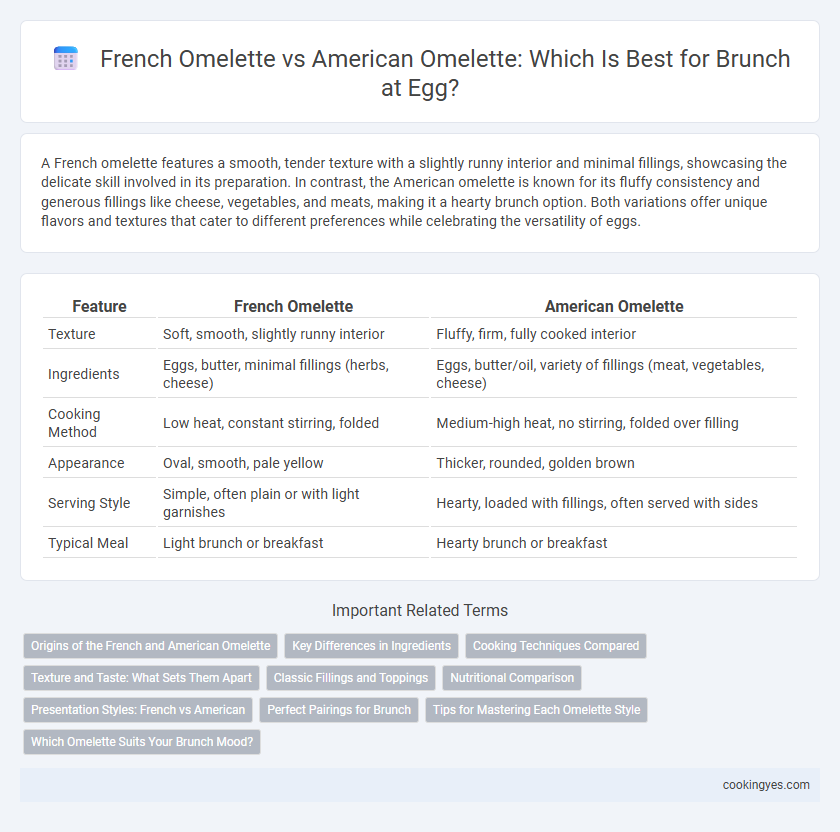A French omelette features a smooth, tender texture with a slightly runny interior and minimal fillings, showcasing the delicate skill involved in its preparation. In contrast, the American omelette is known for its fluffy consistency and generous fillings like cheese, vegetables, and meats, making it a hearty brunch option. Both variations offer unique flavors and textures that cater to different preferences while celebrating the versatility of eggs.
Table of Comparison
| Feature | French Omelette | American Omelette |
|---|---|---|
| Texture | Soft, smooth, slightly runny interior | Fluffy, firm, fully cooked interior |
| Ingredients | Eggs, butter, minimal fillings (herbs, cheese) | Eggs, butter/oil, variety of fillings (meat, vegetables, cheese) |
| Cooking Method | Low heat, constant stirring, folded | Medium-high heat, no stirring, folded over filling |
| Appearance | Oval, smooth, pale yellow | Thicker, rounded, golden brown |
| Serving Style | Simple, often plain or with light garnishes | Hearty, loaded with fillings, often served with sides |
| Typical Meal | Light brunch or breakfast | Hearty brunch or breakfast |
Origins of the French and American Omelette
The French omelette traces its origins to the 16th century, characterized by a smooth, tender texture achieved through gentle folding and minimal browning, reflecting classic French culinary techniques. In contrast, the American omelette emerged in the 19th century, known for its fluffy interior and hearty fillings like cheese, vegetables, and meats, embodying a more robust and diverse brunch tradition. These distinct styles highlight the cultural and culinary evolution of egg dishes in France and the United States.
Key Differences in Ingredients
French omelettes feature a simple blend of beaten eggs, salt, and butter, emphasizing a smooth, silky texture without additional fillings folded inside. American omelettes often incorporate a variety of ingredients such as cheese, vegetables, meats, and herbs mixed into the eggs or folded within, creating a heartier and more textured dish. The French approach prioritizes minimalism and technique, whereas the American version highlights flavor complexity and ingredient diversity.
Cooking Techniques Compared
French omelettes rely on gentle, precise heat with constant whisking to create a soft, smooth, and slightly runny texture, often finished by folding into a neat, cylindrical shape. In contrast, American omelettes use higher heat to achieve a thicker, fully cooked interior, frequently stuffed with various fillings and folded over to contain ingredients like cheese, vegetables, and meats. The French method emphasizes delicate control and minimal browning, while the American style prioritizes heartiness and a more robust, golden exterior.
Texture and Taste: What Sets Them Apart
French omelettes boast a delicate, velvety texture achieved through gentle folding and light cooking, resulting in a creamy interior that highlights subtle egg flavors. In contrast, American omelettes feature a denser, fluffy texture with a fully cooked interior, often loaded with fillings like cheese, vegetables, and meats that create a robust, savory taste. The French omelette's smoothness emphasizes purity, while the American version delivers a hearty, flavor-packed experience perfect for brunch variety.
Classic Fillings and Toppings
French omelettes for brunch typically feature classic fillings like finely chopped herbs (chives, tarragon, parsley) and light cheeses such as Gruyere or Brie, emphasizing a smooth, custardy texture. American omelettes often include heartier fillings and toppings like cheddar cheese, diced ham, bell peppers, onions, and mushrooms, offering a robust and substantial flavor profile. The French style prioritizes simplicity and delicate seasoning, while the American version highlights variety and bold combinations.
Nutritional Comparison
A French omelette typically contains fewer ingredients such as eggs, butter, and herbs, resulting in a lower calorie and fat content compared to an American omelette, which often includes cheese, meats, and vegetables that increase its protein, calorie, and fat levels. The higher presence of cheese and processed meats in an American omelette contributes to increased sodium and saturated fat, whereas the French omelette remains relatively lighter and more nutrient-focused. For a balanced brunch option, the French omelette offers a leaner profile with essential proteins and minimal additives, while the American omelette provides a richer source of vitamins and minerals from its diverse fillings.
Presentation Styles: French vs American
French omelettes showcase a smooth, silky texture with a slightly runny interior, often rolled or folded neatly into a compact oval shape for elegant presentation. American omelettes emphasize a fluffier, fully cooked interior packed with diverse fillings, served open-faced or folded in a more rustic, hearty style. The French style prioritizes a refined, minimalist aesthetic, while the American style focuses on robustness and ingredient visibility.
Perfect Pairings for Brunch
A French omelette, characterized by its smooth, tender texture and minimal fillings, pairs perfectly with light, fresh accompaniments like mixed greens, smoked salmon, or a crisp white wine. In contrast, the hearty American omelette, loaded with cheese, meats, and vegetables, complements robust flavors such as whole-grain toast, breakfast potatoes, and a bold coffee or craft beer. Choosing the right pairings enhances the distinct taste profiles of both omelette styles, elevating the brunch experience.
Tips for Mastering Each Omelette Style
Mastering a French omelette requires gentle whisking of eggs and cooking over low heat to achieve a tender, creamy texture without browning. For an American omelette, whipping eggs vigorously and cooking on medium heat creates a fluffier base that can hold hearty fillings like cheese, vegetables, and meats. Use a non-stick pan and practice precise folding techniques to perfect the classic smooth French style or the robust, stuffed American version.
Which Omelette Suits Your Brunch Mood?
French omelettes offer a delicate, smooth texture with a slightly runny center, perfect for a light, elegant brunch experience. American omelettes provide a hearty meal with a fluffy, fully cooked base and an abundance of fillings like cheese, vegetables, and meats, ideal for a more filling and savory day. Choosing between these depends on whether you prefer a subtle, refined flavor profile or a robust, customizable dish to suit your brunch mood.
French omelette vs American omelette for brunch Infographic

 cookingyes.com
cookingyes.com